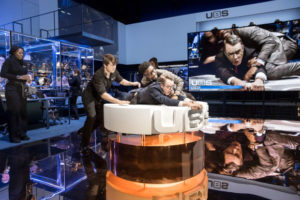
National Theatre incorporates Riedel’s Bolero DECT wireless technology
New technologies are allowing intercom systems to become more integrated, not only for audio but video as well. The National Theatre is among the first to do this with Riedel’s Bolero DECT wireless technology. Kevin Hilton reports…
Breaking away from something you have used and become familiar with over a long period of time is difficult. Technical and production staff at the National Theatre (NT) in London faced this wrench when it was decided to replace the venue’s 15-year-old comms system and move towards an integrated installation connecting security and FOH personnel as well as those backstage.
The National Theatre was founded in 1963 and based initially at the Old Vic theatre in Waterloo. In 1976 a purpose-built theatre was opened on the South Bank of the River Thames. It is an instantly recognisable concrete creation housing three distinct auditoria: the Olivier Theatre, named after the NT’s first artistic director, actor Laurence Olivier, the Lyttelton and the Dorfman (formerly the Cottesloe).
The NT’s head of sound and video, Dominic Bilkey, explains that the decision to replace the previous communications system led to discussions about installing something with greater integration between different departments, including technical, support and security. “The existing Clear-Com analogue matrix had been in place for about 15 years and was coming to the end of its life,” Bilkey says. “The plan was to investigate replacing the matrix and bringing wired and wireless together.” Although Bilkey and his team talked to Clear-Com about the FreeSpeak II wireless system, other manufacturers were also approached. Among them was Riedel, which at the time – around the end of 2016 – was working on what became the Bolero DECT-based range.
Bilkey comments that while installing another matrix was “a given”, there was debate over whether the overall system should be more than that. “We talked about a matrix with a number of party lines and wireless,” he says. “Something we explored with Riedel was whether wired and wireless were different entities or if there could be combinations. This was partly because we were looking to replace the wired party line used for the follow spot operators and supplementary crew, as well as points on stage.”
The NT formed a technical partnership with Riedel to investigate these points and produce something that would fulfil its specific requirements. “For Riedel, this will benefit new products,” comments Bilkey. “It’s allowed us to integrate different aspects of communications used not only in the theatres but also round the rest of the building. We’ve got integration with the God mics [used by the stage manager or director during rehearsals] and the Motorola radio units for the security and supplementary staff. The result is an integrated system weaving through the building.”
The core of this inter-connectivity is the Riedel Artist intercom matrix. Four matrices of different frame sizes are installed round the building: a 128 in the communications room, which provides distribution to the Bolero aerials; another 128 in the Olivier, a 64 for the Lyttelton and a 32 in the Dorfman. “It’s one big Artist network on fibre,” Bilkey explains. “The Bolero aerials are all on Luminex switches, again over fibre, which connect to different spaces.”
These include supplementary panels in office areas, which are linked through AES67 interfaces. There is also an AES67-interfaced feed from the back of the Artist frame into the building’s Cisco routing system, which is used to connect to remote technical units.
A series of eight fixed-base Motorola radio base stations is integrated through the Artist frame, creating a bridge between the production intercom and the security/general purpose comms system. Also key is the Riedel MediorNet MicroN distribution router, which routes signals for the internal HD TV system, with embedded audio from MADI connections, as well as linking to the Dante-based show relay network.
Installation began in June 2017 in the Lyttelton Theatre. The Olivier followed in January this year; Bilkey says that although in the first instance the two systems were separate, integration between the two was soon instigated. “The install into the Lyttelton took about five days,” Bilkey comments. “We used Bolero on a number of shows after that and played around with configurations. We didn’t get it right from the beginning, but that taught us how we wanted the system to run.”
After two technically straightforward productions – an adaptation of Jane Eyre and JT Rogers’ Oslo – towards the end of 2017, the Lyttelton was used for an ambitious stage version of the Sidney Lumet/Paddy Chayefsky 1976 film satire about TV, Network. The staging featured a central TV studio set surrounded by dining tables, where the audience could have dinner while the play went on. Shots from cameras on set were displayed on big screens, with the camera operators part of the action. Each operator wore Bolero belt packs; the system worked with MediorNet to produce pictures as well as providing comms.
The Dorfman Theatre is due to have Bolero installed during May. The wireless intercom will also support this year’s River Stage, the outdoor summer festival that was used as an early try-out of the system during the 2017 season. Bilkey says there are plans to bring the Bolero installation up the theoretical limit of 100 belt packs, although the integrated Motorola radios will most likely be retained due to the number already in use.
He concludes that staff at the NT have been getting used to the new technology: “It’s like driving the same car for 15 years and then jumping into another model. But what sold it was having a single front-end that is part of one big system.”
Source: mi-pro.co.uk



